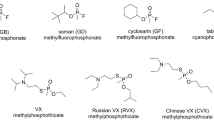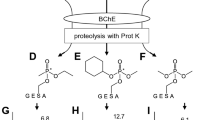Abstract
Neuropathy Target Esterase (NTE) is the molecular target in the nervous system for organophosphorus esters (OP) when they cause delayed polyneuropathy. Some NTE activity was recently found also in blood lymphocytes. An unsuccessful suicide attempt with the widely used pesticide chlorpyrifos (0,0-diethyl-0-3,5,6,-trichloro-2-pyridyl phosphorothioate) is reported, where prior inhibition of lymphocytic NTE correlates with the delayed development of polyneuropathy. A 42-year-old man drank approximately 300 mg/kg chlorpyrifos. The subsequent severe cholinergic syndrome lasted for 17 days with varying degrees of severity. Thirty days after intoxication the clinical and electrophysiological examination of the peripheral nervous system was normal but lymphocytic NTE was about 60% inhibited. On day 43 the patient began to complain of paresthesia and leg weakness. Clinical examination, electrophysiology and a nerve biopsy revealed signs of a peripheral polyneuropathy, axonal in type. This case report indicates that measurement of lymphocytic NTE might be used as a clinical test to predict the development of OP-induced delayed polyneuropathy.
Similar content being viewed by others
References
Bertoncin D, Russolo A, Caroldi S, Lotti M (1985) Neuropathy target esterase in human lymphocytes. Arch Environm Health 40: 139–144
Bidstrup PL, Bonnel JA, Beckett AG (1953) Paralysis following poisoning by a new organic phosphorus insecticide (mipafox): report on two cases. Br Med J 1: 1068–1072
Braddom RL, Schuchmann J (1980) Motor conduction. In: Johnson EV (ed) Practical electromiography. Williams and Wilkins, Baltimore and London, 16–60
Dudek BR, Richardson RJ (1982) Evidence for the existence of neurotoxic esterase in neural and lymphatic tissue of the adult hen. Biochem Pharmacol 31: 1117–1121
Ellman GL, Courtney KK, Andres V, Jr, Featherstone RM (1961) A new and rapid colorimetric determination of acethylcholinesterase activity. Biochem Pharmacol 7: 88–95
Hayes WJ, Jr (1982) Pesticides studied in man. Williams & Wilkins, Baltimore/London, p 398
Jedrzejowska H, Rowinska-Marcinska K, Hoppe B (1980) Neuropathy due to phytosol (Agritox): report of a case. Acta Neuropathol 49: 163–168
Johnson MK (1981) Delayed neurotoxicity; do trichlorphon and/or dichlorvos cause delayed neuropathy in man or in test animals? Acta Pharmacol Toxicol 49 (Suppl. 5) 87–98
Johnson MK (1982) The target for initiation of delayed neurotoxicity by organophosphorus esters: biochemical studies and toxicological applications. Rev Biochem Toxicol 4: 141–212
Kidd JG, Longsworthy OP (1933) Jake paralysis; paralysis following the ingestion of Jamaica ginger extract adulterated with triortho-cresyl phosphate. Bull Johns Hopkins Hosp 52: 39–66
Lotti M, Johnson MK (1978) Neurotoxicity of organophosphorus pesticides: predictions can be based on in vitro studies with hen and human enzymes. Arch Toxicol 41: 215–221
Lotti M, Ferrara SD, Caroldi S, Sinigaglia F (1981) Enzyme studies with human and hen autopsy tissue suggest omethoate does not cause delayed neuropathy in man. Arch Toxicol 48: 265–270
Lotti M, Becker CE, Aminoff MJ, Woodrow JE, Seiber JN, Talcott RE, Richardson RJ (1983) Occupational exposure to the cotton defoliants DEF and Merphos: a rational approach to monitoring organophosphorus-induced delayed neurotoxicity. J Occup Med 25: 517–522
Lotti M, Becker CE, Aminoff MJ (1984) Organophosphate polyneuropathy: pathogenesis and prevention. Neurology 34: 658–662
Osterloh J, Lotti M, Pond SM (1983) Toxicologic studies in a fatal overdose of 2,4-D, MCPP and chlorpyrifos. J Anal Toxicol 7: 125–129
Radomski JL, Rey A (1970) The electron capture detector in the analysis of chlorinated hydrocarbon pesticides in tissues with and without clean-up. J Chromatogr Sci 8: 108–112
Senanayake N, Johnson MK (1982) Acute polyneuropathy after poisoning by a new organophosphate insecticide. New Engl J Med 306: 155–157
Smith HV, Spalding JMK (1959) Outbreak of paralysis in Marocco due to orthocresylphosphate poisoning. Lancet II: 1019–1021
Taylor P (1980) Anticholinesterase agents. In: Gilman AG, Goodman LS, Gilman A (eds) Goodman and Gilman's the pharmacological basis of therapeutics. Macmillan, New York, pp 100–119
Xintaras C, Burg JR, Tanaka S, Lee ST, Johnson BL, Cottrill CA, Bender J (1978) Occupational exposure to leptophos and other chemicals. DHEW (NIOSH) publication no. 78-136, Washington DC, US Government Printing Office
Author information
Authors and Affiliations
Rights and permissions
About this article
Cite this article
Lotti, M., Moretto, A., Zoppellari, R. et al. Inhibition of lymphocytic neuropathy target esterase predicts the development of organophosphate-induced delayed polyneuropathy. Arch Toxicol 59, 176–179 (1986). https://doi.org/10.1007/BF00316329
Received:
Accepted:
Issue Date:
DOI: https://doi.org/10.1007/BF00316329




